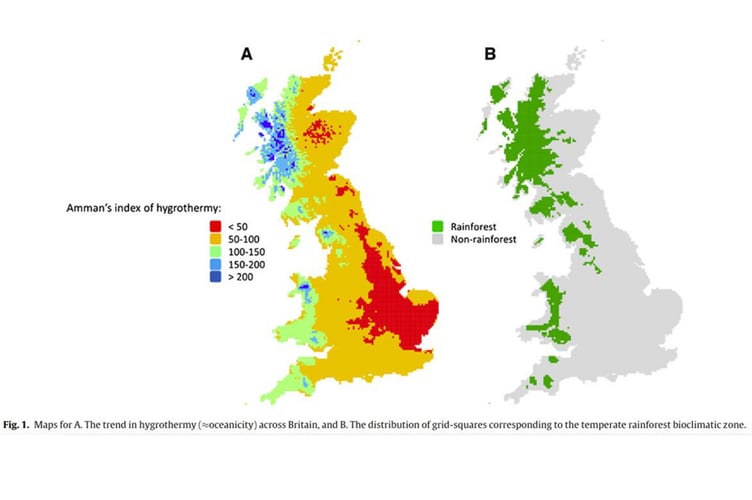A tree campaign group is calling on the UK Government to help protect and restore Britain’s temperate rainforests.
The Lost Rainforests of Britain campaign also put out a major call around Britain for members of the public to help map the remaining fragments of the rainforest habitats in Britain.
Supported by the Eden Project, the Lost Rainforests of Britain campaign lists the Elenydd - an upland area of mid Wales which extends across parts of between Aberystwyth and Rhayader, through northern and eastern Ceredigion and Powys - as one of the major temperate rainforest zones in Britain.
The Lost Rainforests of Britain campaign launched its call to the public on Monday, May 16, to raise awareness of Britain’s unique temperate rainforest and to ask the public to help map the remaining fragments.
Some initial mapping has been done, which can be found on the campaign’s website, but the habitat is so rare that the campaign needs public support to publish a detailed map as campaigners say once the remaining fragments have been found it will be easier to protect them.
The campaign is led by environmental campaigner and author Guy Shrubsole who is also writing a book titled ‘The Lost Rainforests of Britain’.
Historically, temperate rainforests covered a much larger area of Britain and due to Britain’s maritime climate the habitat has the potential to cover 20% of Britain overall. Britain’s temperate rainforests were initially cleared in the Bronze Age and the medieval period, but some were also lost more recently due to forestry policies, and overgrazing is now preventing their return.
Temperate rainforests occur in mid-latitude, temperate zones, in places which received heavy rainfall due to an ‘oceanic’ climate. Temperate rainforests are very damp woodlands – so damp that plants grow on other plants. The key indicator of temperate rainforest in Britain is an abundance of mosses, lichens and polypody ferns festooning the branches and trunks of trees. A guide to identifying temperate rainforest can be found here. Major temperate rainforest zones in Britain are: The Elenydd, Snowdonia, the West Coast of Scotland, the West Country in England, Cumbria, Yorkshire and Lancashire.

The campaign’s research has identified multiple areas across Britain that have the conditions for temperate rainforest. To help map these areas, the campaign is launching a nationwide public call to action asking members of the public to venture into their local woodland and send the campaign any information they find about temperate rainforest, including location and photos, to their website. The Lost Rainforests of Britain has also launched a public petition calling for the Government to protect and restore these habitats by implementing a ‘Great British Rainforests Strategy’.
Campaign lead Guy Shrubsole said: “Few people realise that Britain is home to such a globally rare habitat. Unfortunately, our temperate rainforest only remains in fragmented pockets, but this doesn’t have to be the case. The best way to bring back the lost rainforests is to better protect what we have left, and then allow these rainforests fragments to expand and regenerate naturally. By introducing a Great British Rainforests Strategy and committing significant funding and protection the Government can bring back our lost temperate rainforests by supporting landowners to build a barrier around existing rainforest to stop overgrazing and allow it to regenerate.”
The Eden Project’s David Harland said: “We are thrilled to see the Lost Rainforests of Britain campaign calling for the protection and restoration of temperate rainforests. Here at the Eden Project, we are lucky to have some of our own temperate rainforest that people can visit, so it would be brilliant for the public to get really hands on with this campaign. This is a call to action for people to get involved by exploring and mapping extremely rare temperate rainforest in their local area.”
A recent study measured the scale and speed of natural regeneration that has taken place at two formerly arable farmland sites in England.
The researchers found trees sprouting at distances of 100 to 150 metres from a seed source; half the trees grew from acorns buried by jays, who carried them far from where they fell.
At one of the sites, what had once been an empty field had become 100% closed-canopy woodland within 50 years. At the second site, regeneration was even faster, reaching 86% woody vegetation cover within just 23 years.




